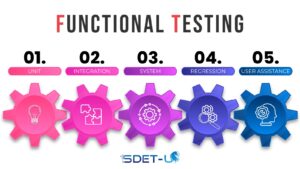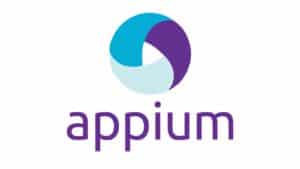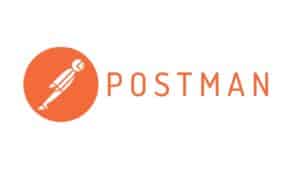Functional Testing and Integration Testing are different testing types that are being used by software testers to identify bugs and errors and ensure the reliability of software before it is released to the end users.
This blog aims to compare functional testing vs integration testing and explains their purpose, usage, and differences. Let’s explore these testing techniques together.
What is Functional Testing?

Functional Testing is a type of software testing that verifies whether all functions of a software are working as intended and they meet user expectations. It involves testing various features such as user interface, modules, and other system components, to ensure that they are working as expected.
Purpose of Functional Testing
- Functional tests ensure that software is working smoothly and functioning as expected. It helps in achieving customer satisfaction.
- Functional tests are commonly used as a black box testing technique. It helps the QA teams to find bugs within the system and fix them before software is released to the end users.
- Where software has a complex nature, functional testing ensures that the software is aligned with standards and improves the testing process.
- Functional Testing tests improve software reliability.
- Where software is critical and sensitive, Functional tests ensure everything works perfectly and avoid future malfunctioning.
Tools Used in Functional Testing
Although Functional Testing can be performed manually, you can use automated tools to perform Functional Testing as well. These are the commonly used tools used in functional testing:
- Selenium
- Appium
- Cypress
- SoapUI
- Playwright
Selenium:

Selenium is known for its remarkable features. It provides flexibility across various programming languages, including Java, Python, and C# and it could also integrate tools and frameworks. That is the reason software testers choose functional testing for automation purposes.
Appium:

It helps software testers automate Functional Testing for mobile applications across various operating systems like iOS and Android. It supports multiple operating systems to test mobile applications. Appium is a perfect tool for handling both native and hybrid mobile applications. Like Selenium, Appium is also flexible with multiple programming languages.
Examples of Functional Testing
Banking Application – Error Handling:
Purpose: In banking systems, functional testing is used to verify the accurate functioning of banking applications and provide the right response when users face any error during a money transfer.
Scenario: Imagine you are using your banking application to transfer money to your friend. You have entered the amount and receipt details, but what happens if you enter the wrong details by mistake? It could be an incorrect account number or an amount exceeding your balance.
Applying Functional Testing:
- Ensure that the application is responding where an error has occurred.
- The application should not crash, instead show a notification like “Invalid Account Number” or “Account not found”
- Verify that it responds as expected
- Display the correct error message
- Maintain a seamless user experience
Pros and Cons of Functional Testing
Functional testing has a significant role in software quality assurance. Its advantages are much more than merely the detection of errors. At the same time, it has some limitations or disadvantages too. Let’s discuss both of them;
Advantages
- Functionality testing ensures that every function and aspect of the software is performing according to the client’s requirements and specifications.
- It prevents misunderstanding and miscommunication among software testing teams by examining software deeply and objectively.
- It helps software testers record the entire process of testing, ensuring that every functionality has been properly scrutinized. This also helps in test documentation.
- It guarantees that all software functions are performing perfectly, thereby gaining customer satisfaction and trustworthiness.
- Functional testing is highly effective in addressing defects in the early stages of software development, saving both time and money.
Disadvantages
- Its main focus is to verify software functions to meet user expectations, however, it does not cover non-functional aspects of software like performance and security.
- Testing every function exhaustively consumes time and effort which reduces test coverage.
- When software is updated, functional testing is performed repeatedly to check that no new defect has arisen. This demands more time and resources.
- There is always a possibility of human error in functional testing. A tester might skip some steps, affecting the reliability of the software.
- Certain testing tools for functionality testing have licensing fees. This limits small testing teams from having limited budgets.
- Setting the necessary infrastructure for functional testing could be a major cost factor.
What is Integration Testing?

In an Agile environment software is always developed in a modular approach. Once a module has been tested it will be integrated with another module. Now testing will be performed to examine whether both modules are working as per expectations after integration or not. Testing at the time of integration is called integration testing.
Integration testing is used when various components and modules of software are integrated and tested as a whole. It ensures that these components are coordinating with each other harmoniously.
It enables software testers to guarantee that all the integrated modules of software are working as a unified system. It also facilitates smooth data flow and reduces the risk of test failure.
Purpose of Integration Testing
- Integration testing is a powerful tool for evaluating different modules of software, ensuring their cohesive performance.
- It confirms that all the functions are accurately interacting with each other as per the intentions.
- Integration testing reduces the risk of serious defects making it easier to meet client’s expectations.
- This testing approach strictly examines the data flow between various components of the system, ensuring that the data is transferred accurately without being corrupted.
- In integrated systems, one component relies on another. In such cases, integration testing ensures that changes in one component do not harm other components.
- It ensures stability and reliability in the entire software system.
Tools Used in Integration Testing
Here are the commonly used tools used in the integration testing process;
- Postman
- Rest Assured
- Citrus Framework
- WireMock
Postman:

This tool is used for testing APIs. It allows testers to run a series of requests to APIs in the form sequence. These requests help testers to verify that different modules are communicating harmoniously.
Citrus Framework:
Specifically designed for integration testing, Citrus provides strong support for automated integration tests for different message protocols and data formats. It’s great for complex integration testing scenarios.
Examples of Integration Testing
Airline Reservation System:
Purpose: For the airline reservation system, consider yourself as a passenger who performs multiple actions such as; selecting a seat, entering passenger details, and making a payment.
Scenario: In this case, integration testing is necessary to validate that all these actions are working well together, ensuring the reservation of seats, correct payment processing, and the quick delivery of a confirmation email.
Applying Integration Testing
- Verify that the system shows correct flight availability and users can access relevant flight searches. These two functions should work together perfectly.
- Validate that the passenger should be able to reserve seats and this should be properly integrated with booking and flight availability components.
- Ensure that all the passenger details are accurately recorded during the booking process and that the payment component of the application is working well with the booking component.
- Confirms that payments are taking place in real-time without any error.
- Ensure that passengers receive confirmation emails immediately after booking.
Pros and Cons of Integration Testing
Integration testing pros have many advantages that have a huge contribution to ensuring the reliability and quality of software. However, it has drawbacks too. Let’s learn about them;
Advantages
- Integration tests systematically verify the interaction between various components and software modules of a system during the software development process, revealing all defects, incompatibilities, and communication errors within such modules.
- It validates the data flow between various integrated components of a system, ensuring that the data is transferred safely without being corrupted.
- Integration testing serves as an express risk mitigation tool, reducing the possibility of system crash and data loss.
- In complex software built, where various components are dependent on one another. Integration testing ensures that changes in one component do not affect the other.
- Integration testing monitors how different modules of a system interact and respond to each other.
Disadvantages
- Integration testing demands specified infrastructure which is costly to set up and requires major resources like hardware, software, and expertise.
- When a component of software is still under development or unavailable, integration testing causes delays in testing procedures.
- A software that is frequently updated, it is challenging to perform integration testing.
- Where different teams are performing tests on different components of a software. Ensuring coordination among them during integration testing could be a challenging task.
- To assure complete test coverage for every test scenario on multiple components of software is difficult to achieve.
When to Choose Functional Testing or Integration Testing?
Functional and integration tests serve different purposes in software quality assurance.
- Functional Testing:
- Best for User Interface (UI): Ideal for assessing the UI of a software application.
- User Interaction Checks: Tests user interaction, functionality of buttons, forms, and other UI elements.
- User-Friendly Validation: Ensures the software meets user expectations and is user-friendly.
- Error Resolution in Component Testing: Helps resolve errors before integrating different software components, especially when different teams work on these components.
- Integration Testing:
- End-to-End Process Examination: Focuses on the entire sequence of interactions and data flow among various components.
- Complex Data Flows: Suitable for software with complex data flows and intricately connected components.
- Comprehensive Coverage: Ensures smooth and accurate data processing and transfer across interconnected components.
- Limitation of Functional Testing: Functional testing may not provide as comprehensive coverage as integration testing in certain scenarios.
Key Differences Between Functional and Integration Testing
| Aspects | Functional Testing | Integration Testing |
|---|---|---|
| Scope | Focuses on individual functions or components of a system. | Emphasize on interaction between multiple components and modules of a software. |
| Objective | Ensures that each function is performing as expected | Ensure that all the components are working seamlessly and working as a unified system |
| Test Environment | Requires an isolated testing environment | Demands comprehensive integrated infrastructure |
| Execution | Executed by testers | Executed by both testers and developers |
| Error Identification | Helps identify issues that may cause interruption in application’s working | Helps identify issues that are expected to occur during integration of different components |
| Timing | It is performed before Integration Testing | It is performed after unit testing and functional and before system testing |
| Usage | It uses the black-box technique. | It uses the gray box testing technique (both white box and black box testing) |
| Tools |
|
|
Conclusion
Functional testing vs integration testing is a common discussion in the field of software development life cycle and quality assurance. Both of them are equally important. They have different jobs and objectives, working together to ensure that the software is reliable for use.
Functional testing is used to verify the functionality of individual parts, whereas Integration testing is used to ensure that all parts of a software are working together perfectly. Together they not only make software stronger in parts but also perform incredibly together.
Frequently Asked Questions
Q. What is the difference between functional testing and integration testing?
Functional Testing: This type of testing focuses on individual functions or features of a software application. It checks if each function works as expected, typically by providing inputs and examining the outputs. It’s mainly concerned with the user interface, usability, and adherence to functional requirements.
Integration Testing: This testing evaluates how different modules or components of a software system work together. It aims to identify issues in the interaction between integrated units. Integration testing is crucial for ensuring that data flows correctly between various parts of the system and that the system functions as a whole.
Q. What is the difference between functional testing and system testing?
A. Functional testing focuses on individual component functions, while system testing assesses the entire system’s functionality.
Q. What are the 4 types of integration testing?
A. The four types of integration testing, known as Big Bang, Top-Down, Bottom-Up, and Incremental integration testing, are used to evaluate component interactions.
Q. What is the difference between functional and regression testing?
A. Functional testing checks if a software component performs as intended, while regression testing ensures that new changes do not negatively impact existing functionalities.
Q. What is the difference between functional test and unit test?
Functional Testing: Tests how the entire application or specific features function from a user’s perspective. It checks if the software meets its functional requirements.
Unit Testing: Focuses on individual components or units of the code. It ensures each part works correctly in isolation, typically done during development.






